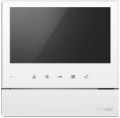Built-in quadrator
The presence of a
built- in quadrator in the intercom.
Quadrator is a device for simultaneous display of video signals from several surveillance cameras; the screen is divided into "tiles", each of which shows a picture from its camera. This allows the user to monitor the cameras without switching or missing "pictures" from any of them, and if necessary, the desired "tile" can be displayed on the entire screen. The simplest quadrators are designed for 4 cameras, however, there are solutions for more — depending on the number of cameras for which the intercom is designed (see below).
Note that a video intercom without this function can be supplemented with an external quad, but it is easier and cheaper to purchase a model where the quad is initially provided in the design.
Intercom connection type
Type of connection with additional monitors (see "Number of monitors") supported by the intercom
—
Consistent. With this type of connection, all external security devices — calling panels, cameras, locks, etc. — are connected only to the main intercom. Additional monitors used in the system are connected in a "chain", one after another, and work only through the main unit; you cannot connect security equipment directly to an additional monitor. With this format of operation, the number of security devices is limited by the capabilities of the main intercom, but they can be accessed from any system monitor.
—
Parallel. Like serial, this option assumes the presence of a main intercom and additional monitors. The key difference lies in the fact that you can connect your own video cameras to each controlled monitor, which will be controlled only from this monitor. This option is convenient when organizing security systems with several separate video surveillance zones: for example, the main monitor can be installed at the main entrance, and the additional monitor at the service entrance, and each of them will only work with the camera above the corresponding door.
Number of ports
The total number of ports for wired connection of various equipment provided in the intercom; in fact — the maximum number of wired devices that can be simultaneously connected to the intercom.
Keep in mind that this number may be less than the total amount of supported devices. This is especially true in models with the possibility of using additional monitors (see "Connected monitors"): such devices are often connected in series, "chained" and occupy only 1 port. Thus, for example, an intercom for 2 calling panels and 3 monitors can have only 3 connectors — one for calling panels and one for monitors. Note also that the LAN port in IP intercoms (see "Device type") is also taken into account in this calculation.
Pluggable outdoor panels
The number of outdoor panels that can be connected to the intercom at the same time.
The call panel is an external panel through which the guest sends a call to the owner of the intercom and communicates with him. Such a panel should be at each door "covered" by the intercom. This means that the number of supported outdoor panels corresponds to the maximum number of doors with which this model can be used. The simplest option is
1 calling panel, but in fact this is often not enough. Therefore, models that can block
2 doors at once are more popular — for example, the main and service entrances to the office. And in the most advanced intercoms, it may be possible to connect
4 calling panels at once, or even
more.
Maximum call duration
The longest continuous conversation that the intercom provides. Technically, this duration can be unlimited, but in fact, limits can also be set — usually from 1 to 4 minutes. This is primarily due to the fact that in systems with several call panels, a conversation through one of them may interfere with the work of the others. Limitations on the duration allow you to exclude long conversations and possible overlays, and the available time is usually enough to clarify all the necessary questions during one conversation. Also, this feature is useful in case you forget to turn off the connection (hang up) at the end of the conversation.
Maximum video viewing time
The longest video duration that the intercom can record for later viewing. This can be either a conversation recording or a video recording of a visitor when working in the “Away” mode. In both cases, a long duration is not required, therefore, in most cases, this parameter is several tens of seconds.
Consumption (standby)
The amount of energy consumed by the intercom in standby mode. In this mode, the device is energized and is in a state of readiness to receive a call; no functions are used, and the readiness itself does not require a lot of energy. Therefore, the value of this parameter, usually, is rather low, and you should pay attention to it only if you fundamentally strive for maximum efficiency of the installed equipment.
Consumption (during operation)
Power consumption of the intercom in the operating mode. Usually, this item indicates the value for situations where the device's functions are used to the fullest — in particular, when the display is on and the speakerphone is on (if any, see above). Note that the consumption in the operating mode rarely exceeds 20 W, so in most cases it is more of a reference, and not a practically significant parameter.

